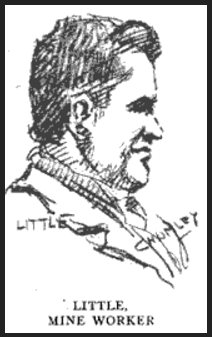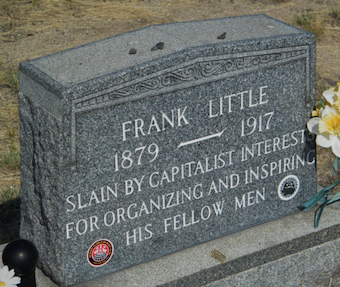Don’t worry, fellow-worker,
all we’re going to need from now on is guts.
-Frank Little
~~~~~~~~~~~~~~~
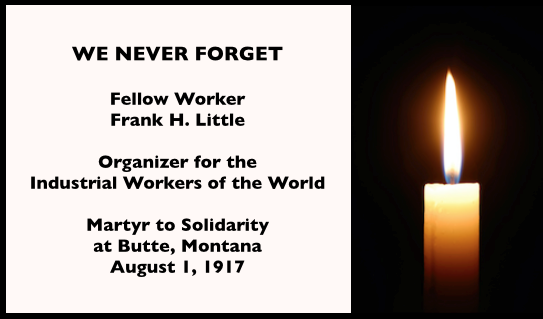
Fellow Worker Frank Little
Organizer for the Industrial Workers of the World
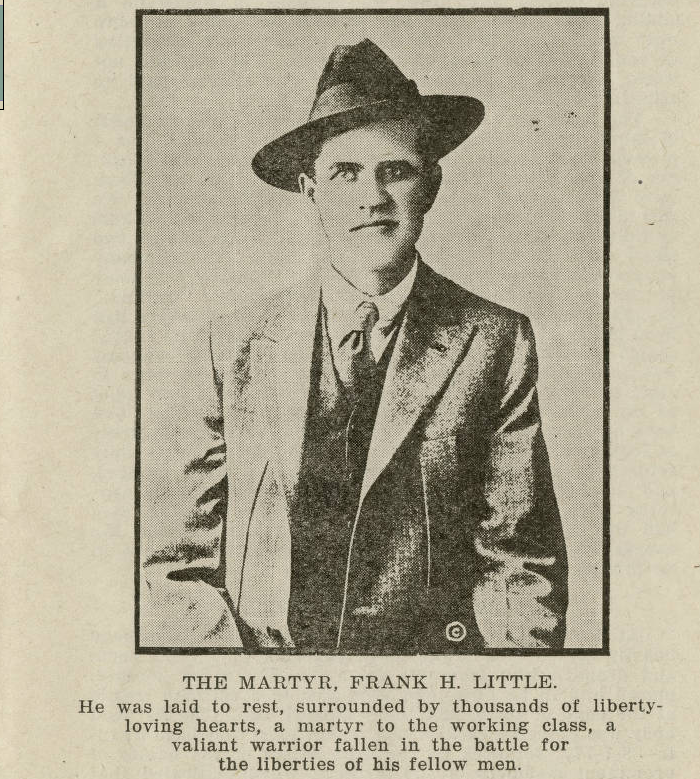
—–
Frank Little was lynched in Butte, Montana, at 3 A. M. on August 1, 1917, by vigilantes who, many alleged, were in the employ of the Anaconda Copper Company. He came to Butte to support striking metal miners despite having been warned of the dangers involved in that assignment. Elizabeth Gurley Flynn said of him:
He was tall and dark, with black hair and black eyes, a slender, gentle and soft-spoken man…He was dependable in all situations.
FW Little was much admired by the miners of Butte, and his funeral was one of the largest ever held in that city. His coffin was covered by a red silk banner, inscribed:
A MARTYR TO SOLIDARITY
———-
Last Meeting with Frank Little
-by Ralph Chaplin
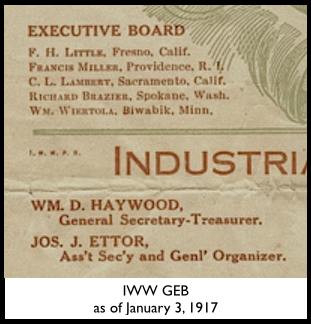
On June 28, Frank Little arrived in Chicago to attend an emergency meeting of the General Executive Board of the Industrial Workers of the World. At issue was the IWW’s position regarding the War in Europe. Ralph Chaplin describes the bitter debate:
Frank Little was the first to arrive.
This time he was on crutches. One leg was in a plaster cast. There had been an automobile accident [near Bowie], Arizona, where he had been directing I.W.W. organization in the copper mines of the Southwest.
But Frank wore his Stetson at the same jaunty angle, and his twisted grin was as aggressive as ever. The General Executive Board went into session. Three days they deliberated without reaching an agreement. At the end of the third day they were still deadlocked. Bill Haywood sent for me, hoping that an appeal from the editor of Solidarity would result in an agreement of some sort. I explained that readers of the official I.W.W. publication were demanding to know the official position of the I.W.W. in regard to the draft and that Solidarity’s deadline demanded an end to the deadlock. I reminded them that at Rockford an entire I.W.W. local, rather than register for the draft, had marched in a body to the police station demanding arrest.
“You must agree on some policy at once,” I insisted. But it was no use. “Some of these two-eyed bastards on the board want to run the show,” said Frank Little. Everybody laughed, but none changed his mind. Frank Little, Bill Haywood, and Dick Brazier were each blind in one eye. But even the one-eyed were not unanimous.
“If we oppose the draft, they’ll run us out of business,” insisted Brazier.
“They’ll run us out of business anyhow,” snapped Frank Little. “Better to go out in a blaze of glory than to give in. Either we’re for this capitalistic slaughterfest, or we’re against it. I’m ready to face a firing squad rather than compromise.”
Bill looked angry, the others bewildered. As the deadline was at hand, I scribbled out a compromise statement. I asked permission to publish it in Solidarity. In it I.W.W. members were advised to register for the draft but to sign as “I.W.W. opposed to war.” The board refused to indorse the statement but told me to “go ahead and print the damn thing” over my own signature. I not only printed the statement in the next issue of Solidarity but I went to my draft board and registered that way.
[About July 11th], Frank Little hobbled up to my office to say goodbye.
He was still disturbed about the action of the board. “You’re wrong about registering for the draft,” he insisted. “It would be better to go down slugging.”
Frank was leaving that day for Butte, Montana, to direct the organizational drive on Anaconda Hill. I marveled at his courage in taking on a difficult and dangerous assignment like that in his present condition.
“It’s a fine specimen the I.W.W. is sending into that tough town,” I chided him. “One leg, one eye, two crutches-and no brains!”
Frank laughed. He lifted a crutch as though to crown me with it. “Don’t worry, fellow-worker, all we’re going to need from now on is guts.”
That was the last time I saw Frank Little alive…
[Emphasis added, photograph added.]
To Help the Striking Miners of Butte
– by Big Bill Haywood:
After the meeting of the Executive Board, Frank Little, a Board member, went to Butte, Montana, [arriving there on July 18th] to assist in the strike there. He was hobbling around on crutches with his leg in a plaster cast, as it had been broken just before he left Arizona. But he felt, in spite of this handicap, that he could do something to help the miners who were then on strike in Butte. He was an energetic worker, part Cherokee Indian, black-eyed, hot-blooded, and reliable.
He addressed several meetings in Butte and it was charged that he made remarks in contempt of the United States troops.
[Emphasis and photograph added.]
MURDER OF FRANK LITTLE
-by George R. Tompkins
At 3 o’clock in the morning of August 1st, six masked heavily armed men broke down the door of Little’s room and dragged him from his room in his night clothes, placed him in an auto, and took him to a railroad trestle at the edge of town, and there hanged him. To his dead body was pinned a card, which read, “First and Last Warning–3-7-77” followed by the first letters of the names of prominent members of the strikers, which indicated that the perpetrators of the crime intended more violence on other members of the strikers.
At the time of his terrible fate Little was on crutches, having sustained a broken leg in an auto accident some time previous. He was also suffering from a rupture [from an earlier attack by gunthugs in El Paso, Texas]. The flesh on the dead man’s body was torn in places, indicating he had been dragged. He had been struck a heavy blow on the back of the head breaking his skull. Before being cut down, bits of flesh were discovered under his finger-nails, bearing evidence of his terrible struggle for life.
[Paragraph break added.]
The Ordeal of Fellow Worker Frank Little
Frank’s body was taken to Duggan’s Undertaking where photographs revealed that the Wobbly organizer’s kneecaps had been scrapped off, his hands mutilated, and his neck, arms, and legs turned black-and-blue with bruises. The coroner’s jury ruled that the cause of death was strangulation by hanging at 3:15 A. M. His neck had not been broken. And he had not been shot. He may have been unconscious before the hanging due to the blows to the back of his head or due to the ordeal suffered as he was dragged behind the murderers’ automobile.
A Red Silk Banner
On August 5th, the streets of Butte were filled with striking miners, their families, and those citizens who stood in Solidarity with the miners in Freedom’s Cause. The procession was led by the American Flag and began at Duggan Funeral Home, led by Tom Campbell and William Dunne [strike leaders]. Frank Little was buried at Mountain View Cemetery out on the flats below Butte.
A red silk banner covered the casket, inscribed:
A MARTYR TO SOLIDARITY
—
The Valiant Warrior
-by George R. Tompkins
The funeral of Little was the largest ever witnessed in the state. Thousands marched in the line of the funeral procession the entire distance of five miles from the city to the cemetery. Thousands upon thousands of people banked the streets along the line of the funeral procession, and in homage to the dead stood with bowed, uncovered head, as the solemn procession passed.
The coffin in which Little’s body rested was borne on the shoulders of his fellow laborers the entire distance. He was laid to rest surrounded by thousands of liberty-loving hearts, a martyr for the working class, a valiant warrior fallen in the battle for the liberties of his fellow men.
Dependable in All Situations
-by Elizabeth Gurley Flynn
When Carlo [Tresca] told me the terrible news I left the stove, sat down and began to cry…
Frank Little had been with us in the Mesabi Range in 1916 in jail with Carlo. Before that I had known him both in Missoula and in Spokane in 1909 and 1910 [Free Speech Fights]. He was tall and dark, with black hair and black eyes, a slender, gentle and soft-spoken man. His one eye gave him a misleadingly sinister appearance. He was part Indian and spoke of himself as “a real American” and a “a real Red.” “The rest of you are immigrants,” he said. He was dependable in all situations. He had been in Arizona when the miners were on strike and had an automobile accident there in which one leg was broken.
He came to Chicago for an executive board meeting on crutches, with the leg in a cast. When he announced he was going to Butte, some of his fellow-workers tried to dissuade him. They knew Butte was a rough and tumble place and were fearful he could not take care of himself in his crippled condition. But he went and made several fiery speeches to the miners…
Whenever I visited Butte in later years I went to his grave out in the flats. It is adorned by a stone erected by the workers of butte, surrounded by the graves of copper miners, victims also of greed and violence in the copper city.
The following month in Chicago, a 61-page federal indictment charged 168 men and women with conspiring “with one Frank Little, now deceased, to hinder and delay the execution of certain laws of the United States” even in death they did not let him rest in peace.
[Photograph and emphasis added.]
Frank Little by N. Schulman
—–
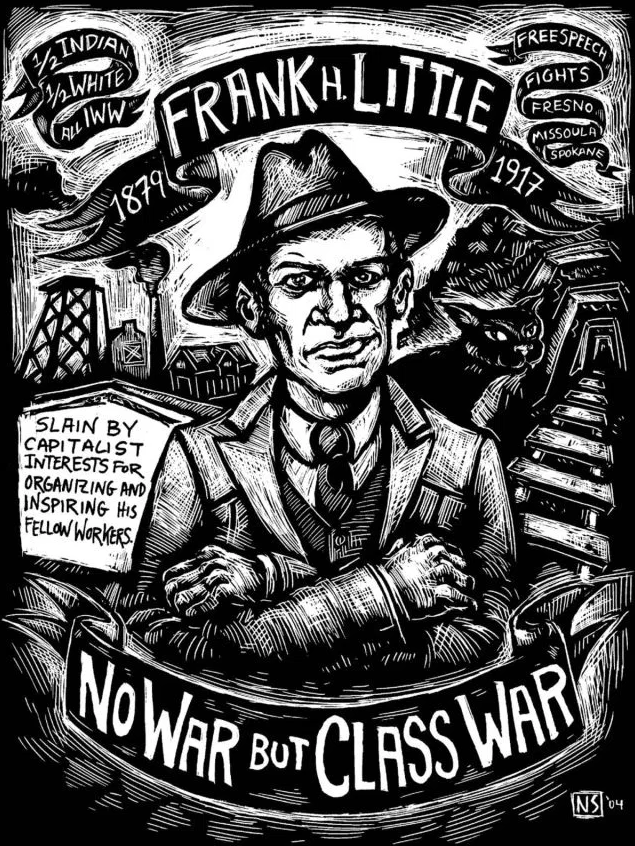
—–
From the Little Red Songbook of 1919:
FAREWELL, FRANK!
(Air: “Barcarolle.” from the “Tales of Hoffman”)
By Gerard J. Lively
You’ve fought your fight, a long good night
Is all that we can say.
Sleep on, sleep on, your work is done
Brave fighter for the Day.
Kind Mother Earth who gave you birth
Receives you to her breast.
For us the Fight, for you the night,
The night of well earned rest,
No more you’ll feel the cling of steel,
You’ve burst the prison bars,
You gave your life in this our strife,
Brave conqueror of stars.
Sleep on, sleep on, your work is done
Sleep on, sleep on, sleep on.
SOURCES
Frank Little and the IWW:
The Blood That Stained an American Family
-by Jane Little Botkin
(Great Grand Niece of FL)
University of Oklahoma Press, May 25, 2017
https://books.google.com/books?id=gBskDwAAQBAJ
Wobbly:
The Rough-and-tumble Story of an American Radical
-by Ralph Chaplin
University of Chicago Press, Jan 1, 1948
(See page 209.)
https://books.google.com/books?id=n-ygPQAACAAJ
Bill Haywood’s Book
The Autobiography of William D. Haywood
-by Big Bill Haywood
International Publishers, 1929
https://catalog.hathitrust.org/Record/000859708
The Truth About Butte
-by George R Tompkins
MT, Sept 20, 1917
http://cdm16013.contentdm.oclc.org/cdm/ref/collection/p267301coll1/id/4294
Montana’s Agony:
Years of War and Hysteria, 1917-1921
-by Arnon Gutfeld
U of Florida, 1979
https://books.google.com/books?id=ODo9PQAACAAJ
The Rebel Girl
-by Elizabeth Gurley Flynn
International Publishers, 1973
https://books.google.com/books?id=TK2y0I-E9EkC
Little Red Song Book of 1919
https://en.wikisource.org/wiki/Songs_of_the_Workers_(15th_edition)/Farewell,_Frank!
IMAGES
Frank Little Martyr, Truth Butte Tompkins, 1917
http://cdm16013.contentdm.oclc.org/cdm/ref/collection/p267301coll1/id/4294
IWW GEB as of Jan 3, 1917
http://garagecollective.blogspot.com/2010/12/little-packet-containing-ashes-of-joe.html
IWWC 1916, Delg Little, ISR Jan 1917
https://books.google.com/books/reader?id=SVRIAAAAYAAJ&printsec=frontcover&output=reader&source=gbs_atb&pg=GBS.PA406
Frank Little Tombstone, FindaGrave
https://www.findagrave.com/cgi-bin/fg.cgi?page=gr&GRid=36564678
Frank Little by N Schulman
Poster for sale by IWW
http://store.iww.org/frank-little-by-n-schulman.html
See also:
Frank Little – A True American Hero
“1/2 White, 1/2 Indian, All I.W.W.”
https://www.iww.org/history/biography/FrankLittle/1
Bio at FindaGrave
https://www.findagrave.com/cgi-bin/fg.cgi?page=gr&GRid=36564678

